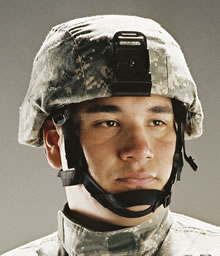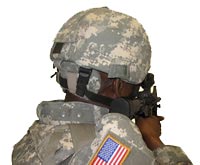The helmet has been the military trademark for centuries. Even today, helmet designers highlight their visual attributes side by side with their ballistic protection and comfort. Modern helmets are lightweight; providing superior ballistic protection and comfort, since they are shaped to optimally fit the individual soldier, even when used with a headwear ensemble.
The US Army has lead the way in helmet designs, Modern designs evolved from 2nd world-war “Steel Pot” helmet, through the more recent Personnel Armor System for Ground Troops (PASGT) helmet designed in the early 1980s, to the latest Advanced Combat Helmet currently issued to combat troops. Other armed forces adapting specific helmet designs include the Russian, British, French, Italian, Australian, Indian and Israeli Armies. The Advanced Combat Helmet (ACH) is replacing the Kevlar PASGT helmet, improving ballistic, impact and blast protection, as well as the weight saving of 3.5 lbs lighter then the old model. ACH uses specially designed suspension to comfortably fit on the Soldiers head. Its design blends better with the soldier’s body armor, enabling less restricted movement even with full protection. The helmet system is compatible with all current accessories, including night vision devices, communications packages, and nuclear, biological, and chemical (NBC) defense equipment.
 The edges of the new helmet have been cut to improve situational awareness through improved field of vision and hearing. The shell provides ballistic protection. While the ACH has 8 percent less surface area than the Personnel Armor System Ground Troops, or Kevlar, helmet had, most of the material was removed from the front of the ACH, with a smaller amount removed from the sides. Nothing was removed from the back of the helmet. Another improvement currently supplied for conventional helmets are impact absorbing pads, also known as “padded helmet suspension systems“, designed to improve blast protection and protect against other non-ballistic impact. The system includes a set of seven pads, replacing the sling suspension used in earlier helmets. It is now standard in US Army ACH and the latest models of the US Marine Corps Combat Helmet.
The edges of the new helmet have been cut to improve situational awareness through improved field of vision and hearing. The shell provides ballistic protection. While the ACH has 8 percent less surface area than the Personnel Armor System Ground Troops, or Kevlar, helmet had, most of the material was removed from the front of the ACH, with a smaller amount removed from the sides. Nothing was removed from the back of the helmet. Another improvement currently supplied for conventional helmets are impact absorbing pads, also known as “padded helmet suspension systems“, designed to improve blast protection and protect against other non-ballistic impact. The system includes a set of seven pads, replacing the sling suspension used in earlier helmets. It is now standard in US Army ACH and the latest models of the US Marine Corps Combat Helmet.
Special gear is designed to protect troops from the effect of blast and flash fire associated with IED explosions, fire bomb attack and penetration of the vehicle’s armor by RPGs and other shaped charge munitions (anti-tank missiles etc.) explosion of burning ammunition or other flammable materials (diesel fuel, hydraulic fluids etc.) present a serious risk to the crews of armored vehicles. Risks of skin burns and internal burns can also be caused by chemical materials. They are addressed by special protection gear designed for NBC protection. Each threat is addressed with a specific protective gear such as Balaclava (ski mask), gloves, eyewear and underwear. For example, the new fire resistant ensemble is composed of up to seven separate layers, providing an effective fire resistant tactical outfit that provides effective protection even under extreme cold weather conditions as low as 50 degrees below zero Fahrenheit. The fire-resistant gear included T-shirts of various types; gloves, boots, coverall, jacket and balaclavas. Initial examples of the new gear were sent by PEO Soldier to Korea and Afghanistan for field testing.
In this series Defense Update covers the following topics:
- Body Armor Suites
- Ergonomic Body Armor Designs
- Ballistic Helmets
- Physiological and Physical Challenge of Body Armor
- Eyewear Protection for the Warfighter
- Tactical Benefits of Laser Eye Surgery (LASIK / PRK)
- Cooling with Phase Change Materials (PCM)
- Improving the Combat Survival Rate Among the Wounded
- Load Carrying Systems for the Infantry
















